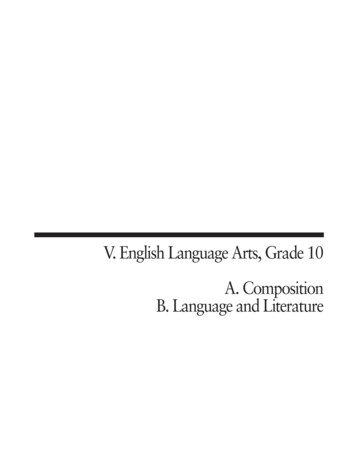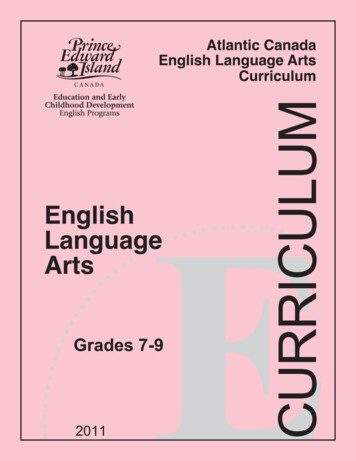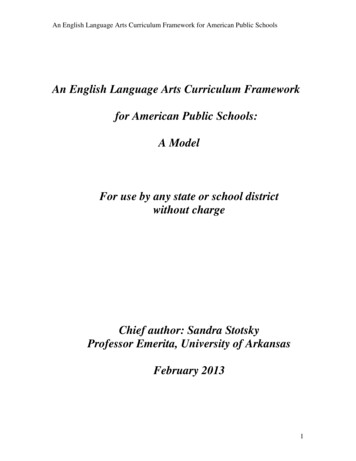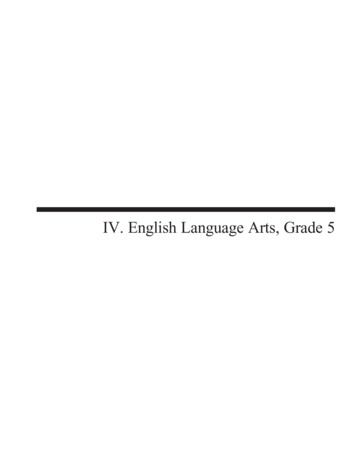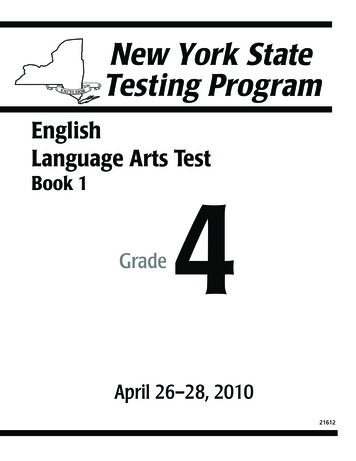
Transcription
EnglishLanguage Arts TestBook 1Grade4April 26–28, 201021612
Tips for taking the testHere are some suggestions to help you do your best: Be sure to read carefully all the directions in the test book. Plan your time. Read each question carefully and think about the answer before choosingyour response.Acknowledgments CTB/McGraw-Hill LLC is indebted to the following for permission to use material in this book:“Belly Flops and Gutter Balls” by JoLynne Ricker Whalen, illustrated by Rocky Fuller from Highlights for Children Magazine’sApril 2005 issue, copyright 2005 by Highlights for Children, Inc., Columbus, Ohio. Used by permission.“The Dragon Hunter” by Keith Wilson from National Geographic Explorer Magazine’s September 2005 issue, copyright 2005by the National Geographic Society. Used by permission.Photograph of dragonfly (Image No. AX001048), copyright by William Dow/Corbis. Used by permission.“About Abigail” by Gail Manning, from Jack and Jill Magazine’s April 2002 issue, copyright 2002 by Children’s Better HealthInstitute, Benjamin Franklin Literary & Medical Society, Inc., Indianapolis, Indiana. Used by permission.“Naming Our Puppy” by Mark G. Merfeld, copyright 2004 by CTB/McGraw-Hill LLC.“Where Does the Water Go?” by Jacqueline J. Christensen, illustration by Michael Palan, from Turtle Magazine’s July/August2006 issue, copyright 2006 by Children’s Better Health Institute, Benjamin Franklin Literary & Medical Society, Inc.,Indianapolis, Indiana. Used by permission.Developed and published by CTB/McGraw-Hill LLC, a subsidiary of The McGraw-Hill Companies, Inc., 20 Ryan Ranch Road, Monterey, California 93940-5703.Copyright 2010 by the New York State Education Department. All rights reserved. No part of this publication may be reproduced or distributed in any form orby any means, or stored in a database or retrieval system, without the prior written permission of the New York State Education Department.
Book 1ReadingDirectionsIn this part of the test, you are going to do some reading. Then you will answerquestions about what you have read.Go On Secure material Do not reproduce. Do not discuss contentsuntil end of designated makeup schedule.Book 1Page
DirectionsRead this story. Then answer questions 1 through 6.Belly Flops and Gutter Ballsby JoLynne Ricker Whalenillustrated by Rocky FullerLewis loved sports. He watched them on TV. He listened to them on theradio. He read about them in the newspaper.One day, Lewis decided that he wanted to be an athlete. “I want to find asport that I’m good at,” he said.“I will help you find one,” said his friend Kirby.They went to the golf course. Lewis picked up a golf club and placed theball on the tee. He swung the club hard, but he missed the ball entirely. Aclump of grass flew into the air and landed on Kirby’s head.“Golf is not for me,” said Lewis.They went to the swimming pool. Lewis climbed the ladder and stood onthe diving board. He took five running steps and sprang into the air. He hitthe water with a stinging smack!Kirby got soaked.“Diving is not for me,” said Lewis.They went to the bowling alley. Lewis held the bowling ball and faced thepins. He hopped and skipped, then let the ball go. It bounced into the nextlane and rolled into the gutter.“Bowling is not for me,” said Lewis.Page Secure material Book 1Do not reproduce. Do not discuss contentsuntil end of designated makeup schedule.
They went to the tennis courts. Lewis tossed the ball into the air and hit itwith the racket. The tennis ball flew right into the net.“Tennis is not for me,” said Lewis.Lewis loved sports. He wanted to learn the basics. He wanted to feel theexcitement. He wanted to enjoy the thrill of winning. Lewis did not give up.They went to the beach. Lewis hopped on a surfboard and caught thewaves. He swerved to the left, leaned to the right, and tumbled off the board.“Surfing is not for me,” said Lewis.Lewis tried volleyball, hockey, skiing, and soccer. He tried boxing, fishing,football, and wrestling. He tried track, basketball, table tennis, and archery.Who would have thought that finding a sport would be so difficult?Lewis sighed. “I’ve tried everything,” he said. “And I’m not good atanything.”Kirby agreed. Lewis had made every possible mistake in every sport!“But, Lewis, you’ve only tried each sport once,” said Kirby. “A goodathlete needs practice.”“Practice?” asked Lewis. “You mean I won’t be good right away?”“That’s right,” answered Kirby.Lewis smiled. “Well, I’d better start practicing!”Go On Secure material Do not reproduce. Do not discuss contentsuntil end of designated makeup schedule.Book 1Page
1This story is mostly about howABCD2being good at sports takes practiceplaying sports with a friend can be funbeing an athlete means trying many sportsplaying sports is better than watching sportsRead this chart about the story.Sport Lewis TriesWhat HappensGolfingHe misses the ball entirely.Diving?BowlingHe throws the ball into the wrong lane.Which statement best completes the chart?ABCD3What brings Lewis closest to his goal in the story?ABCDPageHe falls on the board and breaks it.He slips off the wet ladder.He hits the water with a smack.He climbs the ladder but just stands there. trying sports with a friendlistening to sports on the radioreading about sports in the newspaperwatching sports programs on television Secure material Book 1Do not reproduce. Do not discuss contentsuntil end of designated makeup schedule.
4Which statement about Lewis best tells what this story is about?ABCD5Why does the author most likely include Kirby in the story?ABCD6Lewis reads the newspaper.Lewis tries different sports.Lewis makes a diving mistake.Lewis holds a bowling ball.to show Lewis how to follow rulesto explain to Lewis the importance of exerciseto help Lewis become an athleteto tell Lewis what sports mistakes to avoidRead these sentences from the story.Lewis hopped on a surfboard and caught the waves. He swerved to the left,leaned to the right, and tumbled off the board.The word “tumbled” in the second sentence most likely meansABCDfelljumpedsteppedturnedGo On Secure material Do not reproduce. Do not discuss contentsuntil end of designated makeup schedule.Book 1Page
DirectionsRead this article. Then answer questions 7 through 12.TheDragonHunterby Keith WilsonI am a dragon hunter. Dragonflies, that is! My name is Keith Wilson.I’m an odonatologist. That’s a scientist who studies dragonflies. I don’t huntto kill. I hunt to discover. So far, I have helped to find many new species,or kinds, of dragonflies.Flying ColorsAbout 5,500 dragonfly species buzz around the world. Hunting them isnot easy. Many of them live deep in rain forests. To find them, I have to walkthrough thick bushes. I have to put up with leeches. They are worms thatdrink blood. I even have to watch out for hungry crocodiles.So why do I look for dragonflies? The answer is simple.I love them! They can speed by. They can make sharp turnsand sudden stops. They can hover. They can even fly backward.hover stay stillin the airBest of all, dragonflies are beautiful. They come in manycolors and patterns. Who doesn’t like looking at these amazing insects?Super Sizes***Dragonflies come in many sizes. The smallest one is the size of yourthumbnail. The largest one would cover your face.I recently looked for the heaviest dragonfly in the world—the giantpetaltail. It lives in Australia.You might think such a large bug would be hard to miss. The petaltail,however, is very rare. Few people have ever seen it. After looking for a week,I spotted several of them zooming around.Page Secure material Book 1Do not reproduce. Do not discuss contentsuntil end of designated makeup schedule.
Built to HuntThe hungry petaltails were hunting. Dragonflies are built to hunt. Theyhave two compound eyes. Each eye is made of 30,000 smaller eyes.All those eyes help a dragonfly see everything. A dragonfly can spot atasty meal from up to 18 feet away.Dragonflies have six legs. The insect cannot walk on its legs, however.It uses its four wings to get around. It soars through the sky at 30 milesan hour, looking for prey.From Water to AirA dragonfly begins its life underwater. It hatches from an egg andbecomes a larva. A larva is a young dragonfly. It can swim, but it cannot fly.A larva lives in a lake or stream. It can grow for several years. Then itcrawls out of the water. It sheds its hard skin and becomes an adult.An adult dragonfly doesn’t have much flying time. Some adults live foronly a few weeks. Others are around for several months. During that time,a dragonfly is very busy. It flies. It hunts. It eats. If the dragonfly is female,it also lays eggs. Soon there will be more young dragonflies.Dragonflies in DangerI worry about dragonflies. People are cutting down forests where the bugslive. That could cause some species to die out. I want to protect these tinydragons for others to see and enjoy.78What is this article mostly about?ABCDthe life of dragonflieshow to protect dragonflieshow to photograph dragonfliesthe colors of dragonfliesAccording to the article, what canan adult dragonfly do?ABCDlive for yearsfly backwardwalk on legsswim in waterGo On Secure material Do not reproduce. Do not discuss contentsuntil end of designated makeup schedule.Book 1Page
9Which fact from the article best describes how dragonflies are different fromeach other?ABCD10According to the article, what is the best way to keep dragonflies from disappearing?ABCD11They have six legs.They have compound eyes.They begin life underwater.They are colorful.After reading this article, what could the reader conclude about dragonflies?ABCDPageTeach young dragonflies how to fly.Find an easier way to track dragonflies.Raise dragonflies that can walk on their legs.Stop cutting down forests where dragonflies live.Which detail from the article best supports the idea that dragonflies are built to hunt?ABCD12A dragonfly is built to hunt.The larva of a dragonfly lives in water.A dragonfly can fly up to thirty miles per hour.The smallest dragonfly is the size of a thumbnail. Some dragonflies are in danger.Dragonflies are easy to find.Dragonflies look like tiny dragons.Some dragonflies can be pests. Secure material Book 1Do not reproduce. Do not discuss contentsuntil end of designated makeup schedule.
DirectionsRead this story. Then answer questions 13 through 17.Naming OurPuppyby Mark Merfeld“This is a lot harder thanI thought it would be,” I said.“We’ve been trying to find aname for No-name for a weeknow.”“Why is it so hard, Brian?” asked Mom. “You and Tanya have probablysuggested a hundred names.”“It has to be the right name,” said my little sister, Tanya. “We don’t wantNo-name stuck with a bad name his whole life.”“All I know is you can’t keep calling him No-name,” Mom said. “Sotoday’s the day. You have to agree on a name for the puppy today. Now let’sgo outside and play with him. Maybe he’ll name himself.”As we stepped outside, Tanya screamed, “Look out!”The small, black puppy dashed across the wooden deck and slid intomy feet. He stood on his back legs and scratched excitedly at my shins. Assoon as I reached down to pet him, he gave me a dozen quick licks with histongue. Then he was off to jump on my mom.“Boy, you sure are a little bundle of energy,” Mom said. “Maybe we shouldcall you Tornado.”“How about Hurricane?” Tanya asked. “We could call him Hurry forshort.”The puppy’s timing was perfect. As soon as Tanya finished her sentence,he hurried off the deck into the tall grass in the back yard. Suddenly, hestopped. Something had caught his eye. He charged into the flowerbed andpounced on some purple pansies. A butterfly escaped and fluttered abovehis nose.Go On Secure material Do not reproduce. Do not discuss contentsuntil end of designated makeup schedule.Book 1Page
The puppy chased after it, yapping as he made clumsy little leaps into theair. As he scrambled up the steps, he tripped on the last one and landed onhis chin. He shook his head and continued his chase across the deck. Whenthe butterfly flew off to the side, the puppy tried to turn. The deck was likea wooden ice rink to No-name, and his furry, oversized feet slid out fromunder him. He skidded and flipped over on his side.We were all laughing so hard that we couldn’t grab him as he got up andran into the yard again.“There he goes again,” Tanya said with a giggle. No-name was hoppingthrough the tall grass after two more butterflies. “He sure likes thosebutterflies.”“That’s it!” I shouted. I ran into the house to get the book I had beenreading for school. It was about the Hopi, a Native American tribe inArizona. In the back of the book was a list of Hopi names and theirmeanings.“Look, Mom,” I said, pointing at the list. “We’ve got to call him Nova.”“Why? What does it mean?” she asked.“It means chases butterflies,” I laughed. “Isn’t that perfect?”Mom and Tanya both nodded and laughed, just as Nova made anotherleap into the flowerbed.1314What is this story mostly about?A a brother and sister who argueover a puppy’s nameB a family trying to think of aname for their puppyC a brother who wants to renamethe family’s puppyD a family looking through booksfor puppy namesPage10Why is it taking Tanya and Brianso long to name their puppy?A They like the name healready has.B They cannot think of any names.C They want their mother to namethe puppy.D They want the puppy to have theright name. Secure material Book 1Do not reproduce. Do not discuss contentsuntil end of designated makeup schedule.
15Why does Brian run inside to get a book?ABCD16Why does the author describe the deck as a “wooden ice rink”?ABCD17He remembers something he read.He wants to learn more about butterflies.He is going to read a story to his sister.He needs to finish his homework.It is covered with ice.It is large like a rink.The puppy skates on it.The puppy slips on it.What will Tanya and Brian most likely do the next time they need to name a pet?ABCDThey will watch the pet for ideas.They will look in a book of names.They will ask their mother for help.They will choose a name quickly.Go On Secure material Do not reproduce. Do not discuss contentsuntil end of designated makeup schedule.Book 1Page11
DirectionsRead this poem. Then answer questions 18 through 22.AboutAbigailby Gail ManningOnce a little brownish snail(Her name, I think, was Abigail)Set out to roam the round world through.(She took her little brown home, tooAs every small brown snail must do.)First she crossed the garden wallIn hardly any time at all—An hour at most or was it more,Twenty-nine or thirty-four?(Well, with snails, who keeps the score?)How wide the world!Would courage fail?Was she afraid?Not Abigail!She spied a stone and reached the spotWithin a week (although she hurriedquite a lot).But now a bush sat in her way;Around she crept all night, all day.It was so nice she circled twice!Page12Alas! A jay swooped to the grass.Oh, would he let one brown snail pass?Alarmed, our friend slid in her shellAnd was unharmed till all was well!And then,AND THEN,Now, where was I?Oh, yes, the grass below, the skyBeyond, adventure calls.And so our bold explorer crawlsAnd crawls and crawls(A yawn)And slowly creeps(More yawns and a stretch)While I am fallingFast asleep. Secure material Book 1Do not reproduce. Do not discuss contentsuntil end of designated makeup schedule.
18Which event happens first in thepoem?ABCD19Abigail sees a jay.Abigail spies a stone.Abigail crosses the garden wall.Abigail creeps around a bush.She is a brown snail.She is an explorer.She travels at night.She hides from birds.there.C She will leave her shell behindbecause it is heavy.D She will move fast becauseshe knows the way.22Which event from the poemcould not really happen?A A snail hides from a jay.B A snail circles a bush.C A snail crawls acrossa garden wall.D A snail plans to roamthe world.In the poem, what is Abigail mostafraid of ?ABCDWhat will most likely happen ifAbigail decides to go back to thegarden?A She will get stuck in the bush.B She will take a long time to getWhy does Abigail have to carry herhome with her?ABCD2021the bushthe jaythe garden wallthe wide worldGo On Secure material Do not reproduce. Do not discuss contentsuntil end of designated makeup schedule.Book 1Page13
DirectionsRead this article. Then answer questions 23 through 28.Where Does theWater Go?by Jacqueline J. Christensenillustrated by Michael PalanHave you ever watered a garden and watched the water disappear into thesoil? This fun experiment shows how plants take water from the ground togrow. Ask an adult to help you.You Will Need: Medium-sized glassWaterRed food coloringSpoon1 celery stalk with leavesYou Will Do:1. Fill the glass halfway with water.2. Stir in enough food coloring to make the water dark red.3. Ask Mom or Dad to cut 1 inch off the bottom of the celery stalk. Placethe stalk in the water and let it stand overnight.What Will Happen:The leaves will turn red, as well as the tiny tubes running up through thestalk. Break the stalk in half, and you will see red dots in each piece.Page14 Secure material Book 1Do not reproduce. Do not discuss contentsuntil end of designated makeup schedule.
Why?As a plant grows, its roots act like straws, sucking water up into the stemor stalk. Tiny tubes inside the stalk carry water farther up into the leaves. (Bycoloring the water red, this is easier to see.) The red dots show a cross-sectionof the tiny tubes through which the water traveled.23What is this article mostly about?ABCD24What should you do right after filling the glass halfway with water?ABCD25how water protects plantshow water can change colorshow celery stalks grow in waterhow plants get water from the groundBreak the stalk in half.Place the stalk in the water.Stir in food coloring.Let the celery stand overnight.Which of these items is needed for Step 1 of the experiment?ABCDwaterspooncelery stalkfood coloringGo On Secure material Do not reproduce. Do not discuss contentsuntil end of designated makeup schedule.Book 1Page15
26What should you do right before letting the stalk stand overnight?ABCD27In which section of the article can you find how the water moves through plants?ABCD28Place the stalk in the water.Make the water dark red.Ask an adult to help you.Break the stalk in half.“You Will Need”“You Will Do”“What Will Happen”“Why”After reading the article, a reader could conclude thatABCDplants grow faster in red food coloringwater travels upward through plantsmost experiments require adult helpmany materials are needed for experimentsSTOPPage16 Secure material Book 1Do not reproduce. Do not discuss contentsuntil end of designated makeup schedule.
Grade 4English Language Arts TestBook 1April 26–28, 2010
I am a dragon hunter. Dragonflies, that is! My name is Keith Wilson. I'm an odonatologist. That's a scientist who studies dragonflies. I don't hunt to kill. I hunt to discover. So far, I have helped to find many new species, or kinds, of dragonflies. Flying Colors About 5,500 dragonfly species buzz around the world. Hunting them is not easy.
